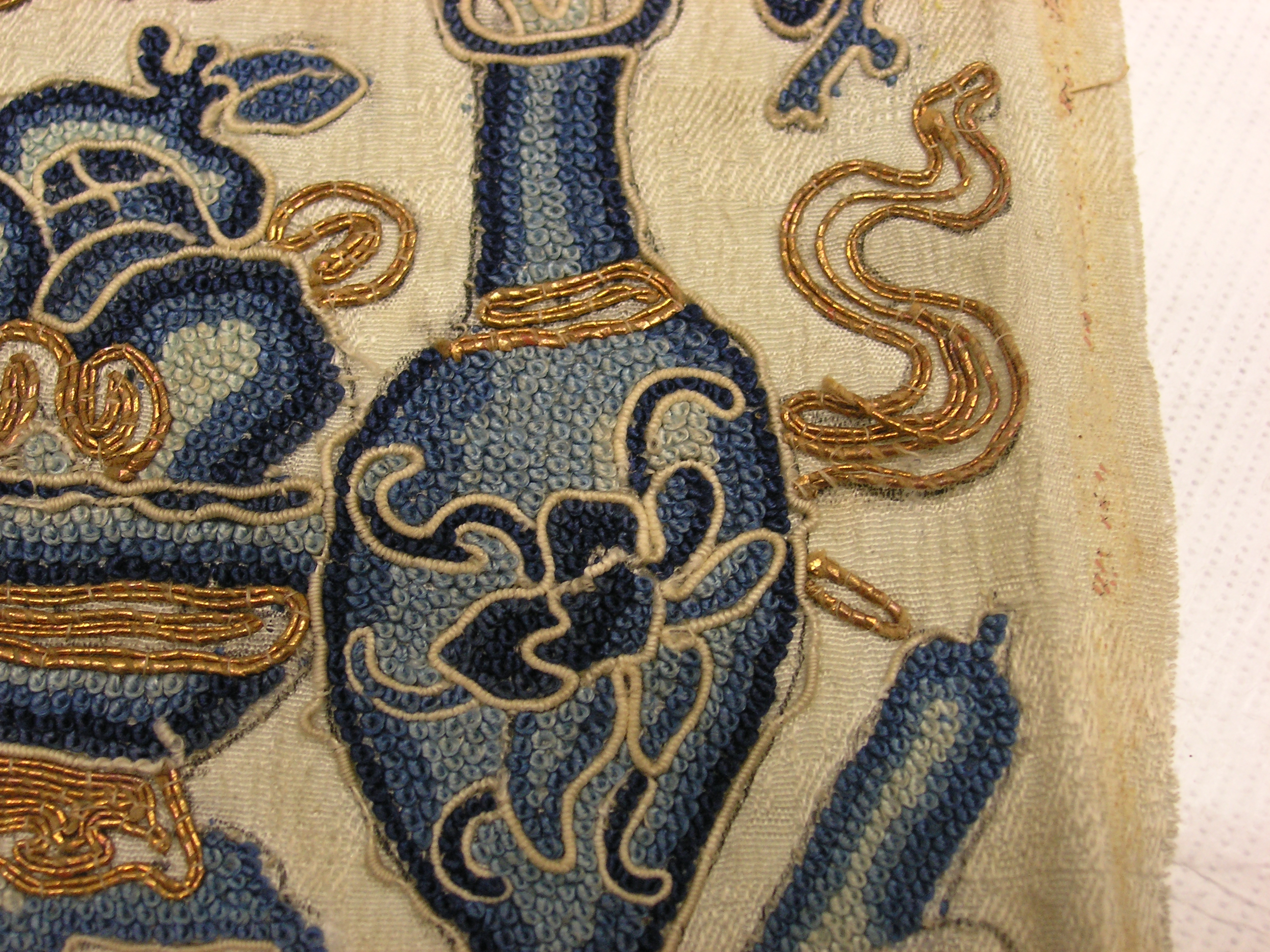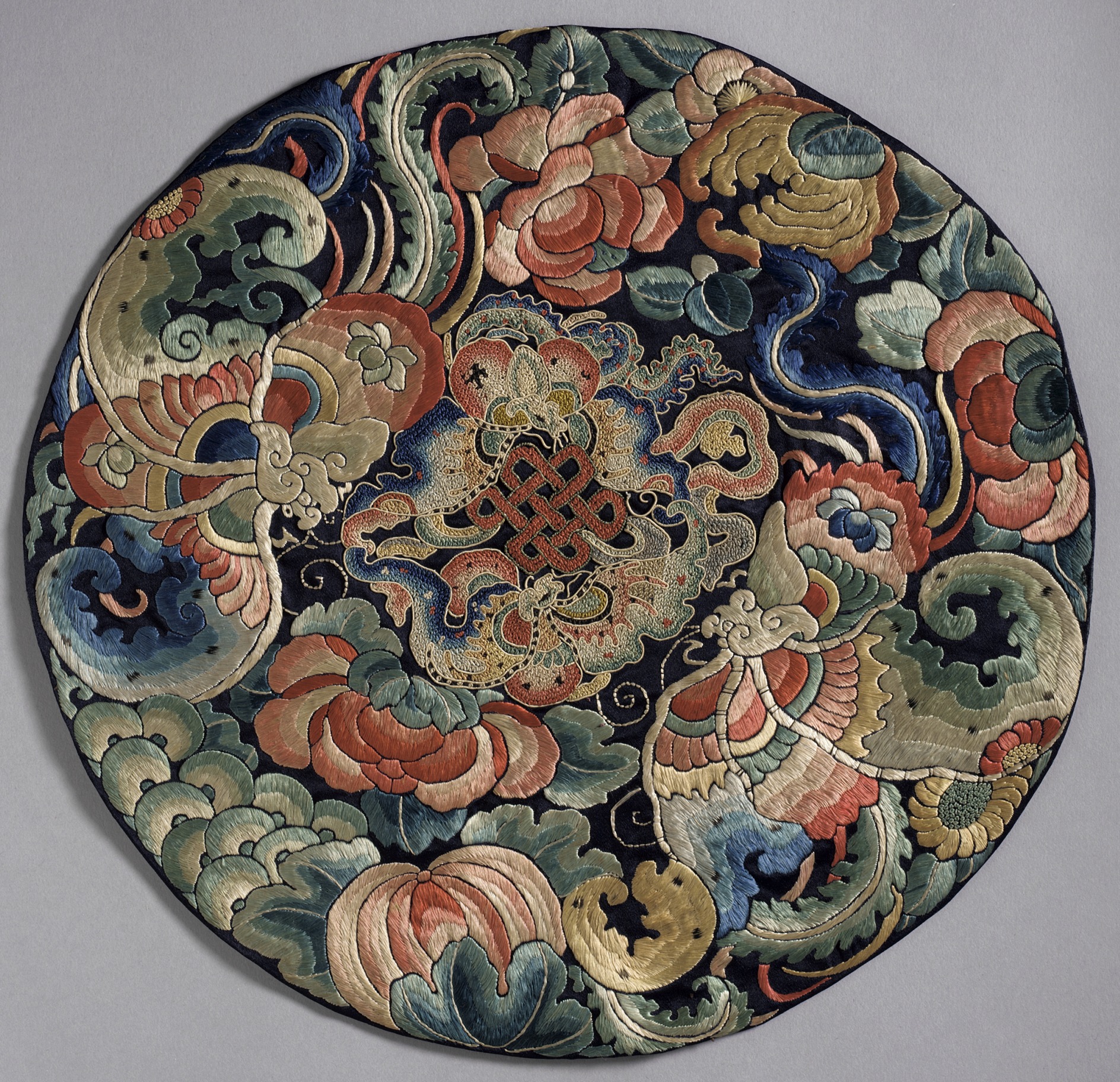Knotted Stitch on:
[Wikipedia]
[Google]
[Amazon]
 A knotted stitch, also known as knot stitch, is any
A knotted stitch, also known as knot stitch, is any
 Embroideries from
Embroideries from
Image:French knots.gif, French knots
Image:Bullion knot.jpg, Bullion knot
Image:Bullion knots.gif, Bullion knots
Image:Four-legged knot stitch.gif, Four-legged knot stitch
Image:Turks head knot.gif, Turk's head knot
Image:Ceylon stitch.gif, Ceylon stitch
Image:Coral stitch.gif, Coral stitch
Image:Zig-zag coral stitch.gif, Zig-zag coral stitch
Image:Double knot stitch.gif, Double knot stitch
Image:Double knot variation.gif, Double knot variation
Image:Knotted cable chain stitch.gif, Knotted cable chain stitch
Project Gutenberg
*Christie, Mrs. Archibald (Grace Christie), ''Samplers and Stitches, a handbook of the embroiderer's art'', London 1920 *Enthoven, Jacqueline: ''The Creative Stitches of Embroidery'', Van Norstrand Rheinhold, 1964, *Reader's Digest, ''Complete Guide to Needlework''. The Reader's Digest Association, Inc. (March 1992). {{embroidery Embroidery Knots
 A knotted stitch, also known as knot stitch, is any
A knotted stitch, also known as knot stitch, is any embroidery
Embroidery is the craft of decorating fabric or other materials using a needle to apply thread or yarn. Embroidery may also incorporate other materials such as pearls, beads, quills, and sequins. In modern days, embroidery is usually seen on c ...
technique in which the yarn or thread is knotted around itself. A knotted stitch is a type of decorative embroidery stitches which form three-dimensional knots on the surface of a textile. Common knotted stitches include French knots, coral stitch,Enthoven, Jacqueline: ''The Creative Stitches of Embroidery'', Van Norstrand Rheinhold, 1964, , p. 153-163Reader's Digest ''Complete Guide to Needlework''. The Reader's Digest Association, Inc. (March 1992). , p. 42-43 and Pekin knot (also known as Forbidden stitch, Pekin stitch, and seed stitch) which is sometimes also referred as French knot although there is a difference in techniques between these two stitches. Knotted stitches can be subdivided into individual or detached knots, continuous knotted stitches, and knotted edgings.
History
Knotted embroidery originated inancient China
The earliest known written records of the history of China date from as early as 1250 BC, from the Shang dynasty (c. 1600–1046 BC), during the reign of king Wu Ding. Ancient historical texts such as the '' Book of Documents'' (early chapte ...
; the oldest example of it dates from the Warring States period
The Warring States period () was an era in History of China#Ancient China, ancient Chinese history characterized by warfare, as well as bureaucratic and military reforms and consolidation. It followed the Spring and Autumn period and concluded ...
in the form a pair of silk
Silk is a natural protein fiber, some forms of which can be woven into textiles. The protein fiber of silk is composed mainly of fibroin and is produced by certain insect larvae to form cocoons. The best-known silk is obtained from the coc ...
shoes. Knotted embroidery was popular in the Han dynasty
The Han dynasty (, ; ) was an imperial dynasty of China (202 BC – 9 AD, 25–220 AD), established by Liu Bang (Emperor Gao) and ruled by the House of Liu. The dynasty was preceded by the short-lived Qin dynasty (221–207 BC) and a warr ...
and fine silk clothing were embellished with the Pekin knot in this period. Knotted embroidery were also used on the mandarin square
A mandarin square ( zh, t=補子, s=补子, hp=bŭzi, w=putzŭ; mnc, m=, v=sabirgi; vi, Bổ tử; Chữ Nho: 補子; ko, 흉배/胸背, hyungbae), also known as a rank badge, was a large embroidered badge sewn onto the surcoat of officials ...
of the Ming
The Ming dynasty (), officially the Great Ming, was an Dynasties in Chinese history, imperial dynasty of China, ruling from 1368 to 1644 following the collapse of the Mongol Empire, Mongol-led Yuan dynasty. The Ming dynasty was the last ort ...
and Qing
The Qing dynasty ( ), officially the Great Qing,, was a Manchu-led imperial dynasty of China and the last orthodox dynasty in Chinese history. It emerged from the Later Jin dynasty founded by the Jianzhou Jurchens, a Tungusic-speaki ...
court clothing of officials. The Pekin knot is one of the two main types of Chinese embroidery
Chinese embroidery refers to embroidery created by any of the cultures located in the area that makes up modern China. It is some of the oldest extant needlework. The four major regional styles of Chinese embroidery are Suzhou embroidery (Su Xiu ...
stitches, with the other being the satin stitch
In sewing and embroidery, a satin stitch or damask stitch is a series of flat stitches that are used to completely cover a section of the background fabric. Narrow rows of satin stitch can be executed on a standard sewing machine using a zigzag ...
.
Embroideries tradition which started in China were passed to other countries through the Silk Road.
 Embroideries from
Embroideries from China
China, officially the People's Republic of China (PRC), is a country in East Asia. It is the world's most populous country, with a population exceeding 1.4 billion, slightly ahead of India. China spans the equivalent of five time zones and ...
and Western Asia
Western Asia, West Asia, or Southwest Asia, is the westernmost subregion of the larger geographical region of Asia, as defined by some academics, UN bodies and other institutions. It is almost entirely a part of the Middle East, and includes Ana ...
were imported to the British Isles
The British Isles are a group of islands in the North Atlantic Ocean off the north-western coast of continental Europe, consisting of the islands of Great Britain, Ireland, the Isle of Man, the Inner and Outer Hebrides, the Northern Isles, ...
, North America
North America is a continent in the Northern Hemisphere and almost entirely within the Western Hemisphere. It is bordered to the north by the Arctic Ocean, to the east by the Atlantic Ocean, to the southeast by South America and the Car ...
and Western Europe
Western Europe is the western region of Europe. The region's countries and territories vary depending on context.
The concept of "the West" appeared in Europe in juxtaposition to "the East" and originally applied to the ancient Mediterranean ...
by the British East India Company
The East India Company (EIC) was an English, and later British, joint-stock company founded in 1600 and dissolved in 1874. It was formed to trade in the Indian Ocean region, initially with the East Indies (the Indian subcontinent and Southea ...
in the 1690s along with many other traded goods. Eastern knotted embroidery became popular among Westerners
The Western world, also known as the West, primarily refers to the various nations and states in the regions of Europe, North America, and Oceania.
. The liking for the Pekin knot eventually influenced the development of tatting
Tatting is a technique for handcrafting a particularly durable lace from a series of knots and loops. Tatting can be used to make lace edging as well as doilies, collars, accessories such as earrings and necklaces, and other decorative pieces. ...
in Western Europe and the British Isles when Europeans sought the knotted effects of the stitches but did not want the time consuming process of stitching tightly packed little knots continuously for long hours.
Applications
Individual knots are often found used as detached filling stitches. Knotted edgings are used as a decorative trims, and can also be used to fill open spaces incutwork
Cutwork or cut work, also known as ''punto tagliato'' in Italian, is a needlework technique in which portions of a textile, typically cotton or linen, are cut away and the resulting "hole" is reinforced and filled with embroidery or needle lace.
...
and in needlelace
Needle lace is a type of lace created using a needle and thread to stitch up hundreds of small stitches to form the lace itself.
In its purest form, the only equipment and materials used are a needle, thread and scissors. The origins of needl ...
.
Detached knots
Individual knots include: *French knot *Bullion knot *Four-legged knot stitch *Turk's head knotKnot gallery
Continuous stitches
Knotted stitches include:Christie, Grace (Mrs. Archibald), ''Samplers and Stitches, a handbook of the embroiderer's art'', London 1920 *Ceylon stitch *Coral stitch or coral knots *Zig-zag coral stitch *Double knot stitch or Smyrna stitch *Knotted cable chain stitch, a knotted variant of cable chain stitchStitch gallery
Knotted edgings
Knotted edgings include: *Antwerp edging *Armenian edging *Hollie stitchSee also
*Cross-stitch
Cross-stitch is a form of sewing and a popular form of counted-thread embroidery in which X-shaped stitches in a tiled, raster-like pattern are used to form a picture. The stitcher counts the threads on a piece of evenweave fabric (such as line ...
*Embroidery stitch
In everyday language, a stitch in the context of embroidery or hand-sewing is defined as the movement of the embroidery needle from the back of the fibre to the front side and back to the back side. The thread stroke on the front side produced b ...
*Tufting
Tufting is a type of textile manufacturing in which a thread is inserted on a primary base.
It is an ancient technique for making warm garments, especially mittens. After the knitting is done, short U-shaped loops of extra yarn are introduced thro ...
Notes
References
*Caulfield, S.F.A., and B.C. Saward, ''The Dictionary of Needlework'', 1885. *Christie, Mrs. Archibald (Grace Christie), ''Embroidery and Tapestry Weaving'', London, John Hogg, 1912, online aProject Gutenberg
*Christie, Mrs. Archibald (Grace Christie), ''Samplers and Stitches, a handbook of the embroiderer's art'', London 1920 *Enthoven, Jacqueline: ''The Creative Stitches of Embroidery'', Van Norstrand Rheinhold, 1964, *Reader's Digest, ''Complete Guide to Needlework''. The Reader's Digest Association, Inc. (March 1992). {{embroidery Embroidery Knots